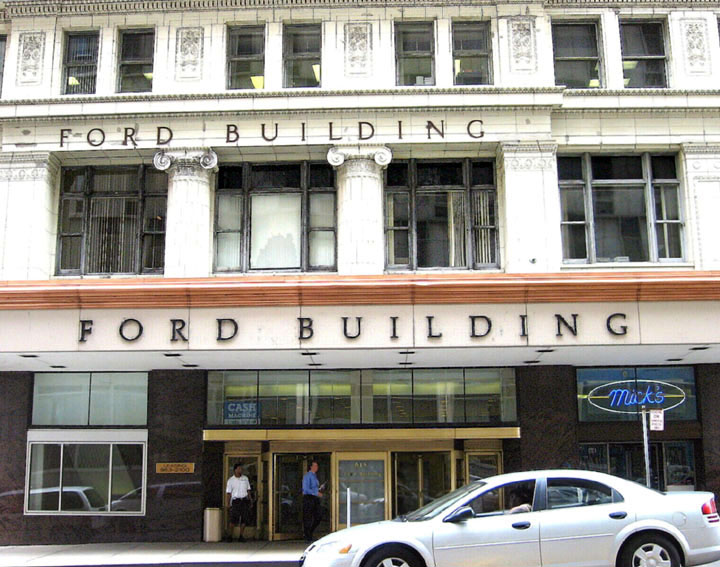Ford Building
615 Griswold Street in downtown Detroit
Daniel Burnham of Chicago was the nation's most acclaimed architect at the turn of the last century. To exaggerate just a bit, you could assert that Burnham and his collaborator, John Root, invented the modern skyscraper. Burnham grew up in Henderson, New York in the mid-1800s, was raised in the Sweden Bourg faith and developed intellectual aspirations. He applied to both Harvard and Yale but was rejected. He migrated to the West and sought public office fruitlessly.
Later he moved to Chicago and accepted a job as apprentice draftsmen for the Carter, Drake and Wright architectural firm. There he met John William Root, another draftsman who became his productive collaborator. After Ms. O'Leary's cow ignited the fire that effectively burned Chicago to the ground in 1871, anyone with minimal design skills found themselves fully employed. In 1873, Burnham and Root started their own firm and successfully specialized in designing large and elegant homes for the city's rich entrepreneurs. In the early 1880s, they began designing large building with a ten-story edifice for a Boston firm.
Recall what was needed for the high rise office buildings that we now take for granted. Businesses must be large and prosperous enough to need a massive amount of space for white-collar bureaucrats. Communications system must be effective enough to centralize the flow of information and documents. Engineering developments were needed, including a basic structure that would reach toward the sky, as well as elevators to serve the upper floors. And then imaginative architects were required, architects willing to attempt what had never been done before. Greek and Roman architects built magnificent public buildings, huge arenas, attractive theaters and great arched bridges and aqueducts, but nothing along the lines of the skyscrapers that Burnham and Root conceived.
In 1886, they combined an interior skeleton of iron with load-bearing external walls and applied these ideas with success in the Rookery Building in Chicago. This was only a start. Burnham realized that industrialization meant that many firms needed huge office buildings and that land at the heart of a city was dear. The solution was to build taller and taller structures. John Root died in 1891, but Burnham continued as one of the nation's leading architects until his death in 1912.
Burnham also played a paternal role in city planning in the United States. The idea of designing cities was not new. Pierre L'Enfant drew up a plan for the nation's capitol in 1891 and Judge Augustus Woodward borrowed those plans and used them in Detroit. By the late 1800s, Baron Georges Haussmann's planning had done much to beautify Paris, giving the world a brilliant example of what an inspiring city should look like. Daniel Burnham designed the buildings that made up the Chicago's Worlds Fair of 1893. His marvelous white structures conveyed an idea of what industrial age cities might look like if they were carefully planned and if resources were devoted to creating appealing structures. These ideas were the foundation of the City Beautiful movement that gradually spread across the nation. Detroit's Cultural Center Historic Distinct is the most visible reminder of how the City Beautiful Movement influenced the Motor City.
Three different entrepreneurial Ford families contributed to the economic development of Detroit. Henry Ford and his descendents are most well known. The Ford Building that you see on this page, however, was not erected by Henry Ford or his relatives. Jean Baptist Ford founded a glass-making firm in Pittsburgh in the mid-19th century. His son remained in the glass business and established the Edward Ford Glass Company in Toledo in the 1880s. Many of the raw materials needed for manufacturing glass were mined in areas between Detroit and Toledo. The Ford Glass company prospered and eventually merged with a rival, the Libby Glass company to form Libby-Owens-Ford. Early automobiles were mostly open coupes so they used relatively little glass, but after about 1910, closed cars became popular so glass manufacturers faced both challenges in making safety glass for motor vehicles, but also a booming market.
The Fords of the glass industry commissioned Daniel Burnham to design Detroit's first skyscraper. He used a steel frame for this 18-story structure and sheathed it with terra cotta. The white exterior not only reminds you of the clean, neat lines of this building, but also stresses its height. This is one of the characteristics of the Chicago style skyscrapers Burnham designed. Two other Burnham buildings enrich the city's architectural treasury—the Dime and the David Whitney. There are obvious similarities, especially when you compare the Ford and Dime Buildings. The perception of the striking height of the Ford building has changed since the adjoining next generation of Detroit skyscrapers—the Buhl, the Penobscot and Guardian buildings showed over the Ford Building. Burnham did not completely split with the classical ideals when designing the Ford. You notice impressive pillars and arched windows toward the roof line.
At this point you might ask about the third Ford family that contributed to Detroit's development. They helped to found the National Bank of Detroit. They comissioned the city favorite architect, Albert Kahn, to design their massive nearby building at Campus Martius.

Architect: Daniel Burnham and Company
Architectural Style: Burnham-influenced Chicago skyscraper of the first generation
Date of Completion: 1909
Use in 2005: Major Office Building
City of Detroit: Local Historic District: Not listed
Michigan Register of Historic Sites: Not listed
National Register of Historic Sites: Not listed
Photograph: Andrew Chandler; July, 2004